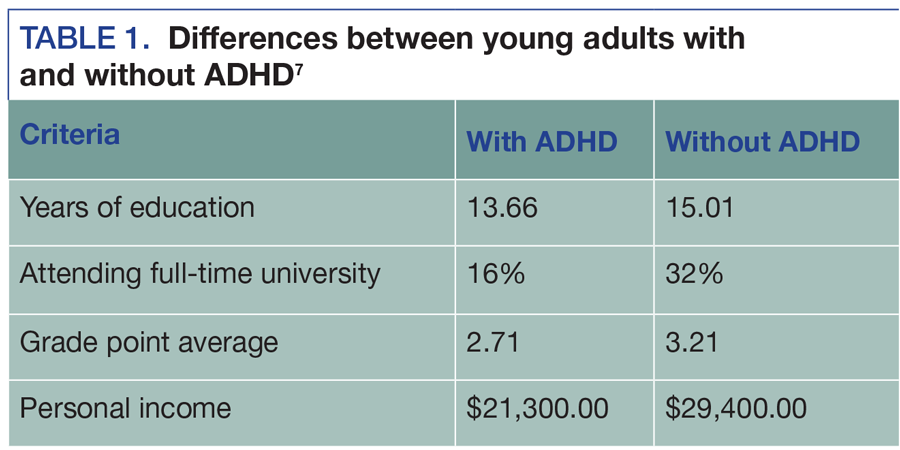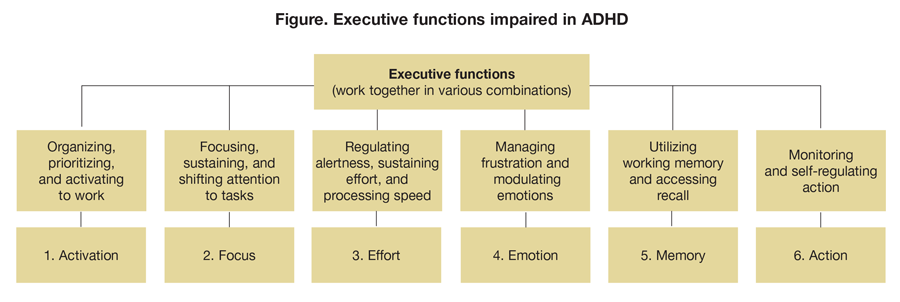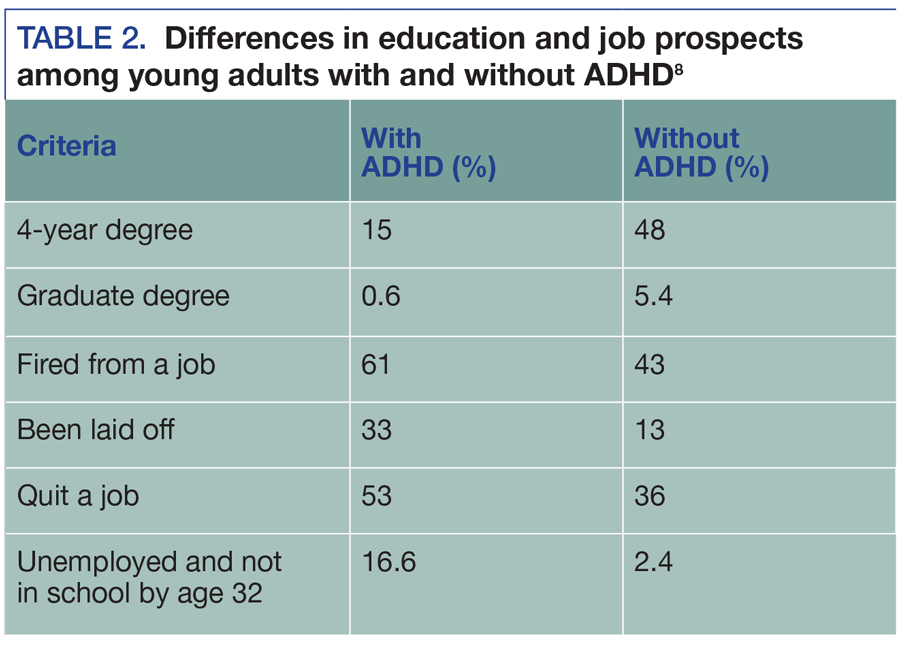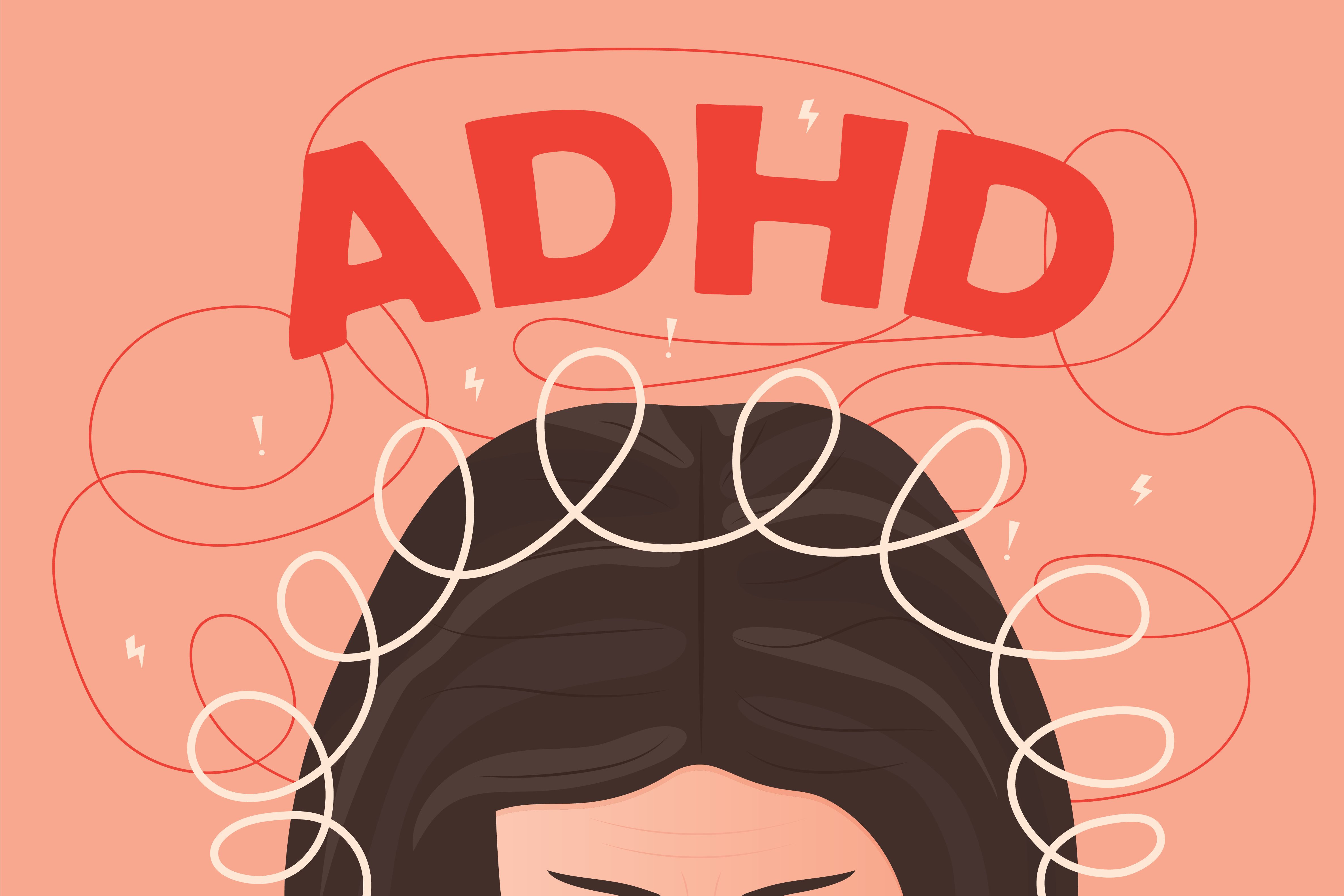Publication
Article
Psychiatric Times
Growing Up With ADHD: Clinical Care Issues
Author(s):
In the years of transition to adulthood, obtaining adequate assessment and treatment for ADHD is often more difficult than at any other point during the lifespan.
TABLE 1. Differences between young adults with and without ADHD

Figure. Executive functions impaired in ADHD

TABLE 2. Differences in education and job prospects among young adults with and without ADHD

For most individuals with ADHD, symptoms persist at least into late adolescence and early adulthood-often much longer. For many, this disorder of the brain’s management system not only persists, it becomes more problematic during the inevitable challenges of early adulthood in which one has to manage much more for oneself. Yet, in the years of transition to adulthood, obtaining adequate assessment and treatment for ADHD is often more difficult than at any other point during the lifespan.
In the US the majority of children with ADHD are identified and treated by pediatricians until they graduate from high school. But assessment and treatment of ADHD in older adolescents and young adults tends to be hit-or-miss once they complete high school and beyond. After leaving high school, some continue to be followed by their pediatricians whom they rarely see if they attend college far from home. Some seek help from an adult primary care physician, many of whom have had virtually no training in diagnosing and treating ADHD. And some who have adequate resources may seek care from a psychiatrist. But many late adolescents and young adults with ADHD do not get any continuing treatment for this disorder at all.
Prevalence and persistence of ADHD
ADHD is not rare among late adolescents and young adults. The National Comorbidity Survey of Adolescents found the prevalence rate of ADHD to be 9% in a large sample of 17- to 18-year-olds.1 In that group the ratio of males to females was 3 to 1. About half of the 9% were identified as having severe ADHD.
For most, ADHD does not remit during young adulthood. A 10-year follow-up study of boys who had received a diagnosis of ADHD in childhood found that 35% of those in their early twenties fully met DSM diagnostic criteria for ADHD and 22% still met at least half of the diagnostic criteria and had significant impairment.2 A follow-up study of girls demonstrated that after 11 years 33% still met full diagnostic criteria for ADHD and 29% continued to meet partial criteria with impairment.3
Moreover, at all age levels ADHD is highly comorbid with other psychiatric disorders.4 A meta-analysis of 21 general population studies of children found that the likelihood of anxiety disorders, depressive disorders, or oppositional/conduct disorders among children with ADHD is respectively 3 times, 5.5 times, and 10.7 times the prevalence of those disorders in the general population of children.5
The National Comorbidity Survey Replication found that adults aged 18 to 44 years with ADHD had more than 6 times the likelihood of having at least one additional psychiatric disorder at some point in their life relative to adults without ADHD. The most common comorbidities were anxiety disorders, mood disorders, impulse disorders, and substance use disorders.6
[[{"type":"media","view_mode":"media_crop","fid":"45070","attributes":{"alt":"© OLLYY/SHUTTERSTOCK.COM","class":"media-image media-image-right","id":"media_crop_9242011663212","media_crop_h":"201","media_crop_image_style":"-1","media_crop_instance":"5103","media_crop_rotate":"0","media_crop_scale_h":"109","media_crop_scale_w":"150","media_crop_w":"276","media_crop_x":"34","media_crop_y":"43","style":"float: right;","title":"© OLLYY/SHUTTERSTOCK.COM","typeof":"foaf:Image"}}]]Functional impairments in young adults
ADHD during late adolescence and early adulthood tends to be associated with significant impairment in multiple domains. One cross-sectional study of young adults with ADHD and matched controls aged, on average, 24 years, found many significant differences between young adults with ADHD and those who did not have this disorder. Those with ADHD tended to have fewer years of education, were less likely to be attending full-time university, had lower grade point averages, and had lower personal incomes despite comparable IQ and similar socioeconomic backgrounds (Table 1).7
A longitudinal study of boys who had had a diagnosis of ADHD versus non-ADHD controls collected information from the youths and their parents each year from age 19 to 32 years (Table 2).8 By age 32, fewer of the young adults with ADHD had earned a 4-year degree and graduate degrees. Occupational experiences were similarly lopsided. Those with ADHD were more likely ever to have been fired from a job, more likely to have been laid off, and more likely to have ever quit a job because they did not like it. By age 32, significantly more in the ADHD group were unemployed and not in school while significantly more in the control group were employed and also in school. Data analysis showed that academic problems and a childhood diagnosis of ADHD were statistically significant predictors of job loss independent of IQ, parental education, high school achievement, disciplinary problems, and post–high school education.
Beyond impairments of school functioning and employment, ADHD has also been shown to increase the risk of relatively early death. A large population-based study found that over a 32-year follow-up, people with ADHD were about twice as likely to die than were people without ADHD.9 Most of these premature deaths were due to accidents and were also associated with untreated ADHD that persisted into adulthood.
Reasons for inadequate treatment
ADHD affects almost 10% of late adolescents and young adults, and it does not usually remit during those years. Furthermore, ADHD often causes significant impairment, is often comorbid with other psychiatric disorders, and carries an increased risk of premature death. Given these sequelae, why is there not better assessment and treatment of ADHD in this age group? Three factors are likely to be involved.
Lack of adequate information about ADHD and its treatment. One reason that many late adolescents and young adults with ADHD do not get adequate assessment and treatment is that many of them-and many of their parents, teachers, and doctors-continue to understand ADHD as a problem linked only to school behaviors. Many are aware of the widespread use of stimulants among high school and college students who take ADHD medication to improve their performance on exams or to help them pull episodic “all nighters” to catch up on overdue work. However, they do not understand the many negative effects of ADHD on daily life or how effective treatment may alleviate impairments in multiple aspects of their functioning.
Unwilling to admit that they need help. Most late adolescents and young adults with ADHD find it very painful to recognize that they are in need of help to deal with demands of school and work. They want to consider themselves grown up and able to take care of themselves. They deny that they cannot overcome chronic struggles that diminish their grades, threaten their job performance, and pose other challenges of adulthood. They may immerse themselves in social activities, computer gaming, or excessive use of drugs or alcohol to avoid facing their increasing difficulty in meeting current challenges.
Lack of resources. Many young adults know where they can occasionally borrow or buy a few doses of stimulant medication to help them study for an exam or write a paper. Yet few know where to get an adequate assessment for ADHD or how to pay for prescribed medication to treat ADHD symptoms. Many college health services will not provide an initial evaluation and diagnosis for ADHD, and some will not refill prescriptions for stimulant medications that have been prescribed by students’ physicians at home. College health services are often overwhelmed by students seeking counseling, and many fear that dispensing ADHD medications will exacerbate inappropriate use among students.
Although there are many credible reports of high school and college students using stimulants not prescribed for them, recent data from the National Survey on Drug Use and Health suggest that many reports of college students abusing stimulants may be unduly alarmist.10 Many of those users tend to be very occasional users (eg, to cram for an exam, finish an overdue assignment). In 2014 the percentage of 18- to 25-year-olds who were current non-medical users of stimulants was 1%, considerably less than the 10.8% in that age group who were heavy users of alcohol and the 19.6% who were current users of marijuana.
New understandings of ADHD
Increasingly, ADHD is being recognized as a developmental impairment of the brain’s management system-its executive functions. One model of the components of this complex disorder is shown in the Figure (details of this model and related information can be found in Brown11).
The symptoms of ADHD can be experienced by anyone at times. ADHD is not an all-or-nothing diagnosis like pregnancy where one either is or is not pregnant, with no in-between. ADHD is more like depression. Everyone feels “down” sometimes, but one does not diagnose clinical depression simply because a person is unhappy for a few days. Likewise, the diagnosis of ADHD is reserved for those with significant chronic impairments.
The most puzzling feature of ADHD is the situational variability of its symptoms. Patients of every age who have ADHD typically report that they can focus their attention very well for a few specific tasks that they have strong personal interest in or when they feel immediate pressure to complete a specific task to prevent some imminent outcome they consider unpleasant. For example, they may be relatively unimpaired by their chronic ADHD symptoms while they play a favorite sport or video game, complete an enjoyable mechanical task, or communicate with others on the Internet. Their chronic procrastination may suddenly disappear the night before they are required to hand in an important report or when a colleague is working beside them.
Seeing an individual’s ability to focus very well and work productively under such circumstances causes some to view ADHD impairments as a simple lack of willpower (eg, “If you can do it here and now, why can’t you do it there and then?”). However, the cause of this situational variability is essentially chemical. When an individual is confronted with a task that he finds genuinely appealing or truly frightening because of perceived negative consequences, the brain instantly provides chemical stimulation to activate relevant executive functions. These chemical activations are not subject to voluntary control any more than is erectile dysfunction.12
Clinical assessment of ADHD
Diagnosis of ADHD is not based on laboratory tests, neuropsychological tests, imaging studies, EEG measures, computer tests, or any other measure that takes a very brief cross-sectional measure of cognitive structure or functioning. ADHD is a clinical diagnosis based on interview and normed rating scale data that take into consideration relevant history and current daily functioning.
In assessing a young adult for ADHD, it is usually helpful, whenever possible, to involve a parent, close friend, or partner who can provide an additional perspective and information beyond patient self- report. Clinical assessment should include an adequate history of the problems that led the patient to seek evaluation; how long these difficulties have been going on; and how much these have impaired the person’s functioning in school, work, and family and social relationships, especially over the past 6 months. Information about current living situation, work and/or school experience, and any major life stressors is also relevant.
The patient history should include current and previous medical or psychiatric problems, current medications, and patterns of eating, sleeping, exercise, and social interaction. It is helpful to ask the patient privately about his or her use of alcohol, marijuana, and other drugs, gently pressing for details about what kind, how much, how often, and with what positive and/or negative effects. To obtain an honest response to such questions, the clinician should first reassure the patient that any such information given privately will not be shared with parents or any others. Questions about anxiety, depression, mood problems, and other possible comorbid psychiatric disorders should also be asked.
Administer an age-appropriate normed ADHD rating scale such as the Barkley Deficits in Executive Functioning Scale, the Brown ADD Rating Scale for Adults, or the Conners’ Adult Attention Rating Scale.13-15 It is useful to administer the rating scale orally so that the patient’s understanding of the questions and responses can be monitored. Patient self-report should be obtained first, followed by responses from any collateral persons. DSM-5 diagnostic criteria for ADHD should also be assessed.
Following data gathering, it can be useful to ask the patient and collateral information providers what they know about the nature, symptoms, and treatment of ADHD. Some are likely to be well-informed, while many have very fragmentary information and considerable misinformation. The clinician should give a brief description of each cluster of ADHD symptoms using examples, and ask how much those symptoms fit or do not fit current functioning. Finally, if the diagnosis is ADHD, with or without another disorder, treatment options are discussed.
Treatment for ADHD
The most effective treatment for most patients with ADHD is medication, usually stimulant medication. Prescribing stimulants for late adolescents and young adults who have ADHD should involve the following considerations.
Medications alone are rarely sufficient to help young adults with ADHD cope effectively with their symptoms.
The dose of stimulant medication that will be effective for any given patient depends not on age, body mass, or symptom severity, but on how sensitive that person is to the medication. Especially in the initial weeks of treatment, careful monitoring of response is needed to guide titration and fine-tune the timing of doses to fit the patient’s body chemistry and schedule. Some students do best with long-acting formulations followed by a “booster” dose of immediate-release medication to provide coverage for evening homework. Others prefer BID or TID dosing of immediate-release stimulants to allow targeting for variable class schedules.
All patients, especially those living in dorms or other shared housing, should be cautioned to protect their ADHD medications carefully and to avoid sharing their medications with anyone else. If they share schedule II medications, they are likely to be besieged by other students wanting to “borrow” or buy meds. To yield to this will deplete their supply, which is tightly limited. It also violates federal laws against distributing such medications and constitutes “dealing” even if no payment is received.
Young adult patients should also be advised that if they regularly consume significant amounts of marijuana while taking ADHD medications, the effects are likely to diminish if not wipe out any benefits. Current data indicate that almost 20% of young adults aged 18 to 25 are current users of marijuana, and 4.9% have a marijuana use disorder.9 Medication treatment for ADHD is not likely to be effective for moderate to heavy users; some with very limited use can function well, but a significant risk remains that light use can easily become impairing use. The risks with alcohol use are similar. Almost 60% of 18- to 25-year-olds currently use alcohol; about 5.9% in this age group have an alcohol use disorder.
Medications alone are rarely sufficient to help young adults with ADHD cope effectively with their symptoms. Psychotherapy (eg, cognitive-behavioral therapy) in a supportive therapeutic relationship can provide critically important support for those struggling with ADHD as they attempt to deal with the frustrations and challenges of transitioning to adulthood.16,17
Disclosures:
Dr Brown is Assistant Clinical Professor of Psychiatry at the Yale Medical School in New Haven, CT, and Associate Director in the department of psychiatry of the Yale Clinic for Attention and Related Disorders. He has directed CME courses on ADHD at the American Psychiatric Association annual meetings for the past 15 years. He reports that he has received research support from Shire, consults for Ironshore, and receives publication royalties from Yale University Press, American Psychiatric Publishing, Routledge, Jossey-Bass/Wiley, and Pearson.
References:
1. Merikangas KR, He JP, Burstein M, et al. Lifetime prevalence of mental disorders in U.S. adolescents: results from the National Comorbidity Survey Replication-Adolescent Supplement (NCS-A). J Am Acad Child Psychiatry. 2010;49:980-989.
2. Biederman J, Petty CR, Evans M, et al. How persistent is ADHD? A controlled 10-year follow-up study of boys with ADHD. Psychiatry Res. 2010;77:299-304.
3. Biederman J, Petty CR, Monuteaux MC, et al. Adult psychiatric outcomes of girls with attention deficit hyperactivity disorder: 11-year follow-up in a longitudinal case-control study. Am J Psychiatry. 2010; 167:409-417.
4. Brown TE, ed. ADHD Comorbidities: Handbook for ADHD Complications in Children and Adults. Washington, DC: American Psychiatric Publishing; 2009.
5. Angold A, Costello EJ, Erkanli A. Comorbidity. J Child Psychol Psychiatry. 1999;40:57-87.
6. Kessler RC, Adler L, Barkley R, et al. The prevalence and correlates of adult ADHD in the United States: results from the National Comorbidity Survey Replication. Am J Psychiatry. 2006;163:716-723.
7. Stavro GM, Ettenhofer ML, Nigg, JT. Executive functions and adaptive functioning in young adult attention-deficit/hyperactivity disorder. J Int Neuropsychol Soc. 2007;13:324-334.
8. Kuriyan AB, Pelham WE Jr, Molina BSG, et al. Young adult educational and vocational outcomes of children diagnosed with ADHD. J Abnorm Child Psychol. 2013;4:27-41.
9. Dalsgaad S, Ostergaard SD, Leckman JF, et al. Mortality in children, adolescents, and adults with attention deficit hyperactivity disorder: a nationwide cohort study. Lancet. 2015;385:2199-2196.
10. Hedden SL, Kennet J, Lipari R, et al, for the Center for Behavioral Health Statistics and Quality. Behavioral Health Trends in the United States: Results From the 2014 National Survey on Drug Use and Health; 2015.
http://www.samhsa.gov/data/sites/default/files/NSDUH-FRR1-2014/NSDUH-FRR1-2014.pdf. Accessed November 30, 2015.
11. Brown TE. A New Understanding of ADHD in Children and Adults: Executive Function Impairments. NY: Routledge; 2013.
12. Brown TE. Attention Deficit Disorders: The Unfocused Mind in Children and Adults. New Haven, CT: Yale University Press; 2005.
13. Barkley RA. Barkley Deficits in Executive Function Scale (BDEFS). NY: The Guilford Press; 2011.
14. Brown TE. Brown Attention-Deficit Disorder Scales for Adolescents and Adults. San Antonio, TX: The Psychological Corporation; 1996.
15. Conners CK, Erhardt D, Sparrow E. CAARS Adult ADHD Rating Scales. Toronto, Ontario, Canada: Multi-Health Systems; 1999.
16. Brown TE. Smart But Stuck: Emotions in Teens and Adults With ADHD. San Francisco: Jossey-Bass; 2014.
17. Ramsay JR, Rostain AL. Cognitive-Behavioral Therapy for Adult ADHD: An Integrative Psychosocial and Medical Approach. 2nd ed. NY: Routledge; 2015.






